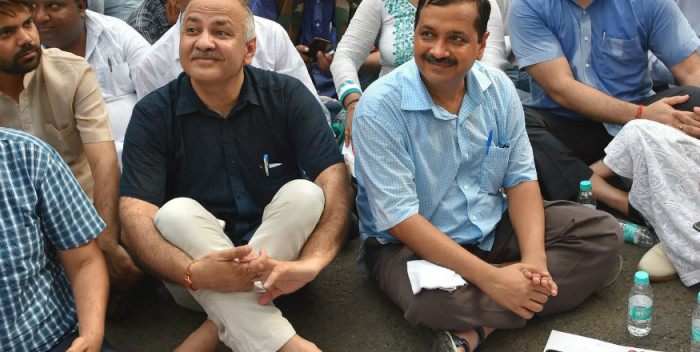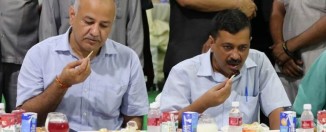Next Milestone in AAP’s U-Turn Drive is Attempting Alliance With Congress
A vehicle on a downhill drive has a peculiar feature. It moves at high-speed and takes several sharp U-turns. In the last six months, the Aam Aadmi Party (AAP) leadership, too, has gone on a U-turn drive, apologising to one and all, and trying to make-up with rivals, including Union Finance Minister Arun Jaitley.
The latest is the reported ‘offer’ made by the AAP leadership to the Congress to enter into some kind of an alliance in Delhi to take on the BJP in the 2019 Lok Sabha elections.
This ‘offer’ comes close on the heels of former Delhi chief minister Sheila Dikshit giving an interview to a Hindi daily saying politics was all about possibilities, and Delhi CM Arvind Kejriwal complementing Delhi Congress president Ajay Maken for his son’s performance in the Board examinations.
Dikshit’s interview, much to the chagrin of Maken, came on the day he was launching a weeklong agitation against the AAP government’s alleged scam in the purchase of close circuit television cameras (CCTVs). Delhi is, thus, being presented with a scenario where on the one hand Maken-led Delhi Congress has upped ante against the AAP government and on the other Kejriwal is going out of his way to build bridges.
AAP leadership’s moves have to be looked at both from the micro and macro perspectives. At the national level, Kejriwal is seeking space in the proposed 2019 anti-BJP alliance. This has presented the Congress leadership with a tricky situation as Kejriwal’s case at the central level is being pushed by West Bengal Chief Minister Mamata Banerjee. Not to forget that in West Bengal, Trinamool leadership has no love lost for the local Congress leadership.
In national politics, with the Left playing the role of the lead lieutenant of the Congress, Mamata would need an aide like Kejriwal to safeguard her space in the national opposition alliance.
On the other hand, at the local level in Delhi, the benefit of the AAP-Congress alliance would be limited to those leaders of the Congress who are opposed to Maken. Kejriwal has reportedly offered such seats to the Congress which could facilitate the entry of Maken’s rivals into the Lok Sabha in 2019.
The ‘offer’ is startling as it’s not easy to forget that the rise of the AAP and Arvind Kejriwal has foundations in the anti-corruption campaign launched against the Congress regimes in Delhi and at the Centre. Having unseated Congress chief minister Sheila Dikshit from power in 2013, it’s truly ironic that Kejriwal is now reaching out to the same ‘corrupt’ Congress leader for an alliance, that too in less than five years.
What brings such change of heart? The answer probably lies in the downslide in the vote share of the AAP in Delhi ever since its peak performance in the 2015 Assembly elections. Though some analysts, and a few Congress leaders pushing for the alliance, point towards the figures of the 2014 Lok Sabha polls, conveniently forgetting that much water has flowed down the Yamuna since then.
It’s true that the AAP and the Congress together have got about 47 percent votes in Delhi in last few polls, whereas the vote share of the BJP since the 1998 Assembly Sabha polls has swung between 32 percent and 36 percent. It’s also true that the division of the votes between the non-BJP parties has helped the BJP score facile victories in Delhi during the 2014 Lok Sabha polls and the 2017 municipal elections.
But there is a difference between the 2014 Lok Sabha polls and 2017 municipal polls. In 2014, AAP’s vote share was 32.9 percent and Congress’ was a meagre 15.1%. In 2017 municipal elections, the AAP vote share came down to 26.21%, whereas the Congress improved its performance to touch 21.21%.
Those opposed to the alliance within the Congress further point out that performance check should be done taking into account the 2015 Assembly elections, where the AAP got a massive share of 54.3%, whereas the Congress was down in the dumps with a single digit figure of mere 9.7%.
Smelling a chance for revival, the present Delhi Congress leadership has also been crying foul over the Election Commission deciding not to appeal against the High Court order restoring the membership of the 20 AAP MLAs disqualified for holding office of profit. For the Congress leaders, it was a chance denied at restoring their political credibility after the zero-seat performance in 2015.
Of the 20 Assembly seats which could have gone to polls, in the event of High Court not intervening, 14 are former Congress strongholds with dominant presence of Dalit and Muslim votes. In the 2015 elections, the two communities travelled lock, stock and barrel from the Congress to the AAP. But thereafter, there have been indications of the two communities returning to the Congress.
If this trend is to continue, the Congress certainly stands to gain nothing much from an alliance with the AAP at the micro-level, though it could provide some amount of political chloramine to the ruling party. And at macro level, outside Delhi, as the results of various state Assembly elections and by-elections have shown, the AAP is fast moving towards extinction, including in states like Punjab where it had some presence.





